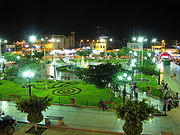
Nazca
Encyclopedia

Peru
Peru , officially the Republic of Peru , is a country in western South America. It is bordered on the north by Ecuador and Colombia, on the east by Brazil, on the southeast by Bolivia, on the south by Chile, and on the west by the Pacific Ocean....
, and the name of the region's largest existing town
Town
A town is a human settlement larger than a village but smaller than a city. The size a settlement must be in order to be called a "town" varies considerably in different parts of the world, so that, for example, many American "small towns" seem to British people to be no more than villages, while...
in the Nazca Province
Nazca Province
The Nazca Province is one of five provinces of the Ica Region of Peru. The capital of the province is the city of Nazca.- Political division :The Nasca Province is divided into five districts , each of which is headed by a mayor :...
. It is also the name applied to the Nazca culture
Nazca culture
The Nazca culture was the archaeological culture that flourished from 100 to 800 CE beside the dry southern coast of Peru in the river valleys of the Rio Grande de Nazca drainage and the Ica Valley...
that flourished in the area between 300 BC and AD 800
800
Year 800 was a leap year starting on Wednesday of the Julian calendar. It was around this time that the Anno Domini calendar era became the prevalent method in Europe for naming years, so from this time on, the years began being known as 800 and onwards.- Europe :* December 25 - Pope Leo III...
. They were responsible for the Nazca Lines
Nazca Lines
The Nazca Lines are a series of ancient geoglyphs located in the Nazca Desert in southern Peru. They were designated a UNESCO World Heritage Site in 1994. The high, arid plateau stretches more than between the towns of Nazca and Palpa on the Pampas de Jumana about 400 km south of Lima...
and the ceremonial city of Cahuachi
Cahuachi
Cahuachi, in Peru, was a major ceremonial center of the Nazca culture and overlooked some of the Nazca lines from 1 CE to about 500 CE. Italian archaeologist Giuseppe Orefici has been excavating the site for the past few decades, bringing a team down every year. The site contains over 40 mounds...
; they also constructed an impressive system of underground aqueduct
Aqueduct
An aqueduct is a water supply or navigable channel constructed to convey water. In modern engineering, the term is used for any system of pipes, ditches, canals, tunnels, and other structures used for this purpose....
s named Puquios
Puquios
The Puquios are an old system of aqueducts near the city of Nazca, Peru. Out of 36 Puquios, most are still functioning and relied upon to bring fresh water into the arid desert. The Puquios have never been fully mapped, nor have any been excavated ....
, that still function today.
On 12 November 1996 at 11:59 a.m. local time (16:59 GMT time) a heavy earthquake
Earthquake
An earthquake is the result of a sudden release of energy in the Earth's crust that creates seismic waves. The seismicity, seismism or seismic activity of an area refers to the frequency, type and size of earthquakes experienced over a period of time...
of 6.4 (the center of the earthquake was 7.7 in the sea) destroyed the city of Nasca and its surroundings almost completely. Because it occurred during the day there were only 17 fatalities, but 1,500 people were injured and around 100,000 left homeless. Almost all old houses in bricks were destroyed, but within 12 years Nasca has been completely rebuilt in colored houses with columns, now often multi-stored houses, with a small boulevard in the center.
Since 1997, Nazca has been the location of a major Canadian
Canada
Canada is a North American country consisting of ten provinces and three territories. Located in the northern part of the continent, it extends from the Atlantic Ocean in the east to the Pacific Ocean in the west, and northward into the Arctic Ocean...
gold mining
Gold mining
Gold mining is the removal of gold from the ground. There are several techniques and processes by which gold may be extracted from the earth.-History:...
operation. The people who were living on the land for the previous 2000 years did not have title
Title (property)
Title is a legal term for a bundle of rights in a piece of property in which a party may own either a legal interest or an equitable interest. The rights in the bundle may be separated and held by different parties. It may also refer to a formal document that serves as evidence of ownership...
to the land, so they were displaced without legal problems. Since then, there have been some attempts to legalize poor citizens' ownership of their land and their fixed property, in response to Hernando de Soto's
Hernando de Soto (economist)
Hernando de Soto is a Peruvian economist known for his work on the informal economy and on the importance of business and property rights. He is the president of the Institute for Liberty and Democracy , located in Lima, Peru.-Childhood and education:Hernando de Soto was born in 1941 in Arequipa,...
research on the poor.
The climate of Nazca is just like the climate of Cusco
Cusco
Cusco , often spelled Cuzco , is a city in southeastern Peru, near the Urubamba Valley of the Andes mountain range. It is the capital of the Cusco Region as well as the Cuzco Province. In 2007, the city had a population of 358,935 which was triple the figure of 20 years ago...
. It is cold during the winter months starting in June and in the summer it is warmer.

